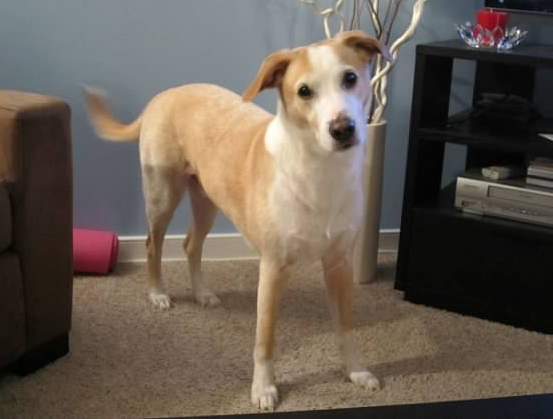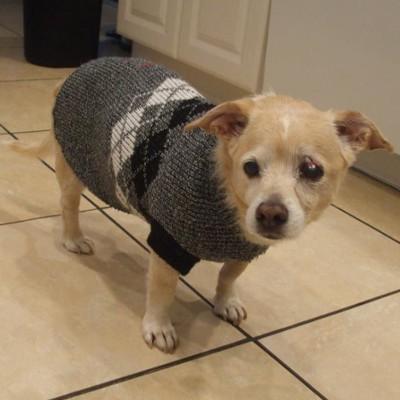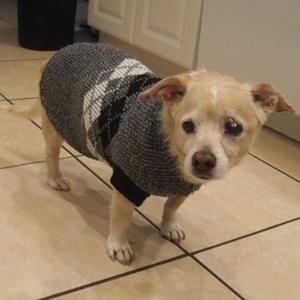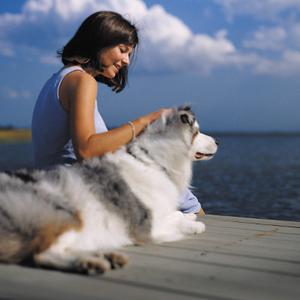 Dogs are known for their noses, which are said to be many times more sensitive than ours. I live in a house with 2 toddlers and a teenager, so I really can't say that an enhanced sense of smell is a good thing in my world. But the way a dog really navigates the world is primarily through their eyes - and keeping a pet's vision safe and healthy is as important for your dog as it is for you and your (human) family.
Dogs are known for their noses, which are said to be many times more sensitive than ours. I live in a house with 2 toddlers and a teenager, so I really can't say that an enhanced sense of smell is a good thing in my world. But the way a dog really navigates the world is primarily through their eyes - and keeping a pet's vision safe and healthy is as important for your dog as it is for you and your (human) family.
So when a dog's eyes fail them and blindness is the result, it can have a serious impact. But that doesn't always mean that they have no quality of life. There are a few important differences between blind dogs and blind humans, and I'd like to talk a bit about them and discus some easy tips for living with a blind dog (or one with decreased vision).
How to Tell If Your Dog Is Sight-Impaired
Before I get to living with, and adapting to, a blind dog, I'd like to cover some signs of eye trouble in dogs, and cover some of the diseases that can lead to blindness. Here are the top 5 signs your dog might be blind. If you notice any of these symptoms, you should visit your veterinarian for a checkup and eye exam. For serious or complicated eye problems, your vet can refer you to a veterinary ophthalmologist (eye specialist).
-
 Running into things around the house - If your pet starts bumping into walls or furniture, they could have a vision problem. Sudden blindness happens, but it's uncommon. The sooner you get to the bottom of it, the sooner you can save or restore vision. Diseases like glaucoma, retinal detachment and inflammation or infection of the eye can all steal vision with little or no warning. In most cases, dogs can adapt to gradual blindness and learn to navigate the house as vision slowly dims. For these pets, a change in the furniture layout may make it look to you, the pet owner, like they've suddenly gone blind. This can also happen when they are taken out of familiar surroundings (where they have a map in their head of how to navigate) like a trip to the vet or groomer. An eye exam, and possibly a visit to an ophthalmologist is needed.
Running into things around the house - If your pet starts bumping into walls or furniture, they could have a vision problem. Sudden blindness happens, but it's uncommon. The sooner you get to the bottom of it, the sooner you can save or restore vision. Diseases like glaucoma, retinal detachment and inflammation or infection of the eye can all steal vision with little or no warning. In most cases, dogs can adapt to gradual blindness and learn to navigate the house as vision slowly dims. For these pets, a change in the furniture layout may make it look to you, the pet owner, like they've suddenly gone blind. This can also happen when they are taken out of familiar surroundings (where they have a map in their head of how to navigate) like a trip to the vet or groomer. An eye exam, and possibly a visit to an ophthalmologist is needed. - Red eyes - If the white part of the eye becomes red and angry, this could be a symptom of serious eye trouble. It can be just allergies or a mild case of conjunctivitis (pink eye), but more serious diseases like glaucoma can also show up with a red eye. Your veterinarian has the knowledge and equipment to tell which is which, so don't wait. If it's one of the bad ones like glaucoma, the sooner you get it treated the better chance you have of saving your dog's vision.
- White areas inside the eye - A cataract is a solid white, crystalline structure inside the eye, which is different from something called nuclear sclerosis - see below on eye changes that are not an emergency and don't cause blindness. This white part is the lens of the eye. With a cataract, the normal clear part changes to white and pets can't see through the opaque lens. Cataracts can happen quickly or slowly and are most common in diabetics. As long as the retina (the part of the eye that receives images) is normal, surgery to remove the cataract can prevent blindness, but this requires the services of a veterinary ophthalmologist.
- Green discharge - A very common eye condition that affects many dogs is called keratoconjunctivitis sicca, shortened to KCS, and also called 'dry eye'. KCS develops when the immune system attacks the cells that produce tears. When dogs stop producing normal tears, mucus glands in the eyes overproduce mucus to try and lubricate the eye, hence the thick green discharge characteristic of this disease. It's easy for dry, irritated eyes to get infections, since the natural defense of tears is lost. Often the clear outer part of the eye (the cornea) can look dull and dry as well. Serious infections and injuries can also produce pus, which is thick and green. Anytime you see green eye discharge, it's time to see your vet, who can help determine if it's a simple case of conjunctivitis that needs some topical medication, or if it's something more serious and threatens vision.
- Eye pain - Dogs with eye pain often do several things - they withdraw and avoid contact with family. They might snap or growl if you come too near their eye, or they may cry out in discomfort. Some pets can also squint in daylight, or paw at their eyes. If you think your dog has eye pain, make an appointment to see your vet right away. They can treat the pain while they sort out what's wrong with the eye and fix it.
There are also 2 common eye-related issues that don't usually cause vision problems but can be confused for some of the problems above. Some dogs have smaller tear ducts than normal, and tears spill over and run down the cheek. This produces a red discoloration on the fur below the eyes, but this is just a cosmetic problem and not a threat to their vision. Also, as dogs get older, the lens inside the eye loses fluid and becomes slightly cloudy or bluish. This is normal and doesn't usually affect vision. It is important to differentiate this from a cataract (see above), as the two conditions can be confused.
Living with a Blind Dog
A big difference between a blind human and a blind dog is that the human knows they are blind. This realization can add an extra added dimension of fear or anxiety that dogs don't have. A human may consciously realize the impact that decreased vision will have on their life, family and work. For a dog, this higher level of concern doesn't happen in the same way, so they are mercifully spared the worry and anxiety that people with impaired vision may experience. If you are told that your dog is blind, or losing their vision, rest assured that they can still live an enjoyable and fulfilling life, as long as pain is well controlled.
 The first thing to make sure of with a blind, or vision-impaired, dog is their safety - followed closely by yours and that of your family. Make sure that blind dogs can't fall down stairs, or into the pool. Ensure that doors and gates stay closed so that they can't wander off.
The first thing to make sure of with a blind, or vision-impaired, dog is their safety - followed closely by yours and that of your family. Make sure that blind dogs can't fall down stairs, or into the pool. Ensure that doors and gates stay closed so that they can't wander off.
Since a blind dog may not see you (or a child) until you are close, approach them slowly and try to make noise so they know you are near. Many blind dogs also have diminished hearing, so a gentle shake (and readiness to back away if they are startled) can do the trick. Make sure children know how to approach and safely handle a blind dog. For those that are too young to comprehend, make sure they are supervised and the dog is kept apart from them.
Avoid rearranging the furniture, or if you must do it, do it gradually so your blind dog can adapt to the new layout. Your vet, possibly with the help of a veterinary eye specialist, can often preserve or restore vision. But when they can't, don't despair. A blind dog can be a happy dog if you know what you're dealing with and take the steps needed to help them make the most of their life and keep them safe.







